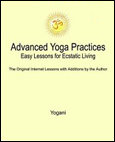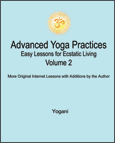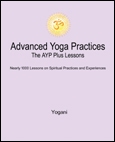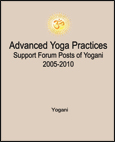|
Public Home | Plus Home | Main Lessons | Tantra Lessons | Public Forum | Plus Forum | Downloads | Books Topic Paths | Search | Training-Retreats | Testimonials | Survey | Interviews | MultiMedia | Contact | Donate |
|
Advanced Yoga Practices Note: For the Original Internet Lessons with additions, see the AYP Easy Lessons Books. For the Expanded and Interactive Internet Lessons, AYP Online Books, Audiobooks and more, see AYP Plus. Lesson 349 - The Convergence of Bhakti and Self-Inquiry (Audio)
From: Yogani New Visitors: It is recommended you read from the beginning of the archive, as previous lessons are prerequisite to this one. The first lesson is, "Why This Discussion?"
Here, we'd like to take a closer look at the mechanism of this refinement in desire in relation to the intellect, and, in particular, the role of bhakti within the process of self-inquiry itself. For most of us, bhakti is pretty easy to understand. We have a feeling, a longing, a desire for something. When that desire/feeling becomes directed toward a high ideal of our choosing, and is sustained in thought word and deed, then that is the expression of devotion, or bhakti. As we have discussed in recent lessons, the characteristics of bhakti are identifiable, and so are the results, at least qualitatively they are. We have even gone so far as to call bhakti the "science of devotion." Some might call that a stretch, but no one can deny the power of emotional longing when brought into the spiritual arena, particularly when powerful yoga practices are systematically applied within the framework of our spiritual desire, where each feeds the other in ever-expanding waves of longing, mingling with the rise of abiding inner silence and ecstatic conductivity. Indeed, the profound results of such an endeavor have given rise to an over-arching category of practice we call "self-pacing." No more must practitioners beg for a few crumbs of spiritual experience. Now it can pour out of us at rates requiring ongoing regulation of practices to preserve reasonable stability of our unfoldment on the path. This is all well and good, but what of the role of self-inquiry? At first glance, it is not nearly as comprehendible as bhakti. This is owing largely to the entrenched assumption that self-inquiry is an intellectual pursuit using the mind to conquer the mind. It is a wrong assumption. If it does not lead to trouble sooner in the form of top-heavy intellectualizations, it can weigh us down later by distracting us from our practices that really do work with a lot of unnecessary progress assessment and self-judgment. This is also sometimes referred to as "psyching ourselves out." Neither has anything to do with self-inquiry. Self-inquiry is a practice that is entirely dependent on the degree of abiding inner silence (witness) we have available at any point in time. With a sound daily practice of deep meditation in use, inner silence will be steadily on the rise, and, with it, our ability for effective self-inquiry. This has been discussed in detail in recent lessons. Self-inquiry, and its very nature at any point in time, is a continuum that weaves its way through the five stages of mind discussed in Lesson 327, from pre-witnessing, to witnessing, to discrimination, to dispassion, to unity. It is this "moving target" aspect of self-inquiry that makes it difficult to prescribe a particular style of practice that can be applied with equal effectiveness at all times. Many have asked what the AYP procedure for self-inquiry is, and the answer has always been that it will vary depending on where the practitioner is in their process of purification and opening and the rise of abiding inner silence. In pre-witnessing stage, very little self-inquiry is recommended. Just meditate and go out and live fully. In witnessing stage, we begin to see our thoughts and their resulting feelings as objects separate from our stillness, and can question the truth of them and release or transform them to improve the quality of our life. This style of self-inquiry has been popularized by Byron Katie, Lester Levenson, and others. As with all forms of self-inquiry, it relies on the emerging presence of the abiding witness for its effectiveness. As the duality between witnessing and the objects of perception becomes more pronounced, we naturally enter the discrimination stage. We may continue with the formal or informal inquiry we have adopted during witnessing stage, but will find ourselves refining our view to a more intuitive perception of inner and outer objects as we become experientially convinced that our true Self is outside the field of perception of objects altogether. We may resort to affirmations on this (I am That). But, ultimately, discrimination is about the negation of the reality of all objects of perception that are bound by time and space. For those who come to this kind of discrimination prematurely, it may be viewed as a negation of life, which is entirely untrue. When the temporal is released in stillness (relationally), the eternal is revealed, which is all life, all love, and all existence. At its appropriate time, discrimination leads naturally to loving dispassion with regard to all that is temporal, and that lands us finally in the stage of eternal unity and outpouring divine love. In the end, it isn't about "objects" at all, but about abiding in the ever-blissful and unknowable Self, which is no-thing at all, yet, contains within it everything that appears to be manifest. At that stage the simple question, "Who am I?" asked with deep feeling in relation to any object of perception is more than enough. The answer is not to be found anywhere in the mind, but in release into the condition that the question inspires. And this becomes our permanent condition, even as our body/mind and outpouring divine love continue to function normally in the world. The later stage methods of self-inquiry are represented in the teachings of Ramana Maharshi and Nisargadatta Maharaj, and by the many who have followed in their footsteps with varying degrees of effectiveness in relation to their students. From a teaching standpoint (particularly in modern times), what often gets lost in the shuffle in all of this is the bhakti that keeps us moving through the various stages of mind, and continues as the radiant loving quality of our Self. Without a doubt, we can say that without bhakti there could be no effective self-inquiry or enlightenment. In fact, effective self-inquiry is pure bhakti. They are one and the same. We long to know who and what we are, and it is that longing that is the question, "Who am I?" We begin with that and we end with that. Along the way, we learn the methods that are necessary for our longing to fulfill its convergence with knowing. Since we cannot know the unknowable Self, bhakti and self-inquiry merge and we consciously become the Self. Some will say, "You always have been the Self. There was never anything to become!" True. But it is a truth spoken in untruth, because for each of us perception is 100% of our reality. While the truth is that we are the eternal Self, the perception must be changed for that truth to be experienced in fullness. That change is a process, a journey that each of us will take as we are inspired to do so. It begins and ends with our sincere longing, and our willingness to act at every step along the way. The guru is in you.
Bhakti Related Lessons Topic Path Discuss this Lesson in the AYP Plus Support Forum Note: For detailed discussion on the merging of bhakti and self-inquiry, see the Self-Inquiry book and the Liberation book. For detailed discussion on the merging of bhakti with all aspects of practice as we progress on our path, see the Bhakti and Karma Yoga book. Also see AYP Plus. |
|
|
|
Join the Mail List:
AYP Retreats
eBooks - PDF, EPUB
FREE eBooks with
SAVE with Bundled
|

























